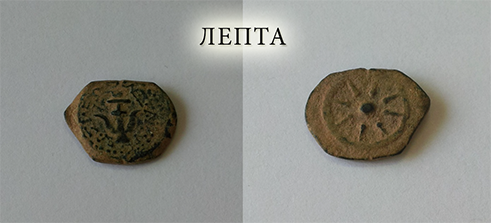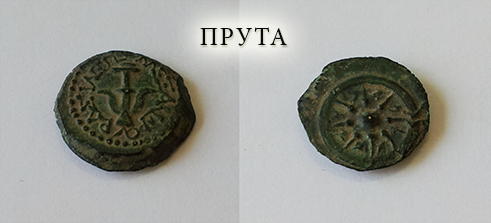Poor Widow’s Mite (Lepton)
In the spring of this year my collection of artifacts was supplied with two lepta, which I brought back from my trip to Israel and Palestine. For the first time we learn about lepton from the Bible. Chapter 21 of the Gospel of Luke narrates one story, of which Jesus Christ was a witness.
«And He looked up and saw the rich putting their gifts into the treasury, and He saw also a certain poor widow putting in two mites. So He said, “Truly I say to you that this poor widow has put in more than all; for all these out of their abundance have put in offerings for God, but she out of her poverty put in all the livelihood that she had.»
(Gospel of Luke 21:1-4)
There are two different, but very similar coins, that are mentioned as the “widow’s lepton”. The smaller one – lepton, and the bigger one – prutah, were minted under Alexander Jannaeus, who was the king and high priest of Israel in 103-76 BC. The difference between these two coins is small, nevertheless, there is a difference.
According to the Bible, the smaller ones (lepta), were the coins that were used by the poor widow. In King James’ Bible (1611) the word «mite» (meaning a very modest contribution) is used to denote this known coin. The original Greek word was lepton (λεπτον). It was the coin of the minimal value that circulated in Jerusalem in the lifetime of Jesus Christ. These coins were thin, roughly and carelessly minted, usually off-centered and struck on little pieces of metal that had been previously cut. The coins’ legends are almost illegible. The size of the coins is like that of a pencil eraser. The coins’ nominal value was based on their weight in comparison to other coins, and not on the proper value of the coin. Presumably, these were the coins that were mentioned in the Bible story of the poor widow.
Along with the smaller lepton, a larger prutah was used. On both of these coins there was an image of an anchor on one side and of a star (or a wheel) on the other side. When numerous hoards with these coins are sorted out, usually both prutot and lepta are found. Despite the fact that only lepton is mentioned in the Bible, since there is so much in common between these two coins, today both of them are usually considered as the “widow’s mite.”
Images and inscriptions on the coins:
Bronze lepton. Obverse: anchor with (or without) a full circle around it. Reverse: 8-pointed star, sometimes with an inscription around it.
Bronze prutah. Obverse: BASILEWS ALEXANDROU (King Alexander) around the anchor. Reverse: 8-pointed star, surrounded by a diadem (full circle, which sometimes looks like a wheel), inscription in ancient Hebrew, “The King Jehonathan” between the rays.
According to some opinion, one prutah equaled two lepta in value; and now historians are faced with the following dilemma: what particular coins the poor widow offered to God, was it two coins – lepta, or just one coin – prutah?



